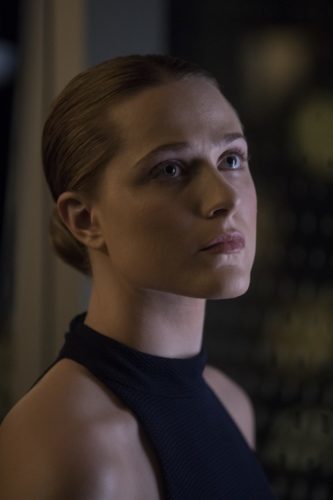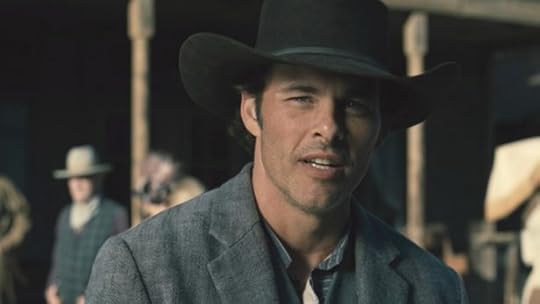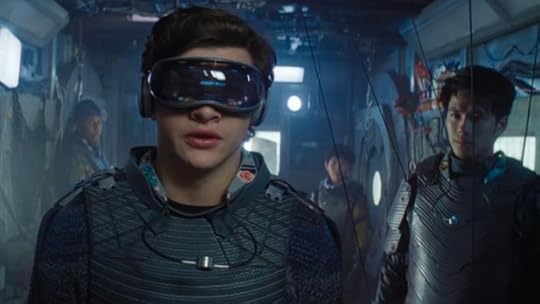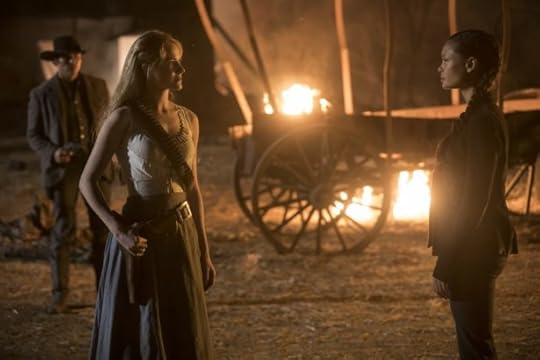Chris Hardwick's Blog, page 1769
April 30, 2018
We’re Even More Terrified of HEREDITARY After This Latest Teaser
A24‘s Hereditary has an insane amount of buzz. The horror flick premiered at Sundance to shining reviews, currently boasts a 100% on Rotten Tomatoes, and has drawn comparisons to all-timer juggernauts like The Exorcist and Rosemary’s Baby. The first trailer was mesmerizing and horrific, showing off first-time director Ari Aster‘s unique visual style. Now, we have a new teaser focused on Toni Collette, whose performance as a grieving daughter and traumatized mother is already garnering Oscar talk.
Yikes.
Here’s the official plot synopsis for Hereditary:
“When Ellen, the matriarch of the Graham family, passes away, her daughter’s family begins to unravel cryptic and increasingly terrifying secrets about their ancestry. The more they discover, the more they find themselves trying to outrun the sinister fate they seem to have inherited.”
The new teaser hints at tension between Collette’s Annie and her son Peter (Alex Wolff). She erupts on him at the dinner table, as husband Steve (Gabriel Byrne) tries to mediate. “Nobody admits anything they’ve done!” she screams. But what is it they’ve done? Looks like that’s another big question we have going into Hereditary, along with, “What the hell is up with that little girl’s weird dolls?”
Collette has been a powerhouse performer for a long time now, and her devastating turn in The Sixth Sense showed that she could bring a lot of emotional weight to a horror film. We can’t wait to see what she does in a role that the trailer boasts is “the best work of her career.”
Hereditary opens June 8. Are you scared yet?
Image: A24
More scary stuff!
A new book explores the real murder that inspired Twin Peaks
One theater accidentally showed a Hereditary trailer before Peter Rabbit
The xenomorph gets its own Funko Pop!
A Heartfelt Farewell to a Departed Marvel Favorite After AVENGERS: INFINITY WAR
Warning: Major plot points for Avengers: Infinity War follow, so only read further if you’ve seen the film, unless you don’t mind being spoiled!
Long ago, back in the days of the Marvel Cinematic Universe’s Phase 1, we devoted viewers could never have suspected we’d ever truly mourn a character like Loki of Asgard. But the brilliant yet conniving youngest son of Odin—the one we met in the first Thor who schemed to steal his brother’s throne, the one who attacked Earth in Marvel’s The Avengers, the one who faked his death and deposed his father in The Dark World, the one ignoring his kingdom at the start of Ragnarok—is not the Loki whose loss we grieve over after Thanos snapped his neck in Infinity War. More than any other character in the entire MCU, he grew into someone worthy of being remembered. And someone worthy of our tears.

Like most great villains, Loki was someone we could empathize with, and someone whose motivations were understandable even while his detestable actions weren’t. He grew up feeling he was “different,” as though he didn’t even belong in his own home, and inadequate in the shadow of his communally beloved older brother, despite the latter’s flaws. In fact, Loki wasn’t wrong that the Thor we met originally would have been a terrible king. Trying to annihilate an entire race to prove his worthiness to his father, on the other hand, was not exactly the best decision.
Things got even worse when he turned up on Earth with the Chitauri Scepter and a drive to enslaved and slaughter countless innocent people. Sure, Loki was as just charming and brilliant as we remembered him, but this time without an empathetic thread.
But then came Thor: The Dark World, the first step in Loki’s earnest journey of personal growth. Here, he was forced to face the consequences of his selfishness as he sat in an Asgard prison for his crimes while his mother was killed by the Dark Elves. He had used his anger at his father—who, right or wrong, had tried to protect his son from a painful truth—as a shield to deny his love for her. But when she was gone, in part because he wasn’t there to save her, it left Loki broken. The great and powerful god destroyed his cell like a child. Only then did he stand with his brother to avenge their mother he had loved.
We mourned Loki at the end of the film, when, like Thor, we thought he died fighting bravely beside his brother. But we mourned him as a villain who grasped redemption—hardly a great hero. Of course it turned out he faked his own death and cast his father from Asgard so he could rule in his stead. (So, again, hardly a great hero.)
When we met him again at the start of Ragnarok, he had turned out to be at least as terrible and selfish ruler as he ever could have predicted Thor would be. He abandoned his responsibility as Protector of the Nine Realms to bask in his own heroics. Everything he had done prior to make us believe he had grown seemingly went out the window. The selfish god had tricked us, and Asgard, into rooting for him.

But something happened in Ragnarok that finally got through to Loki. In between efforts in winning favor of Sakaar’s maniacal Grandmaster and trying to double-cross his brother yet again, Loki and Thor had a conversation that would ultimately prove to be the most important Loki ever had in becoming the person Thor believed he always could be:
After Thor submits that Loki is perfect for the “savage, chaotic, lawless” world of Sakaar, a dejected Loki said, “You truly think so little of me,” to which Thor responded, “Loki, I thought the world of you. I thought we were going to fight side by side forever. But at the end of the day, you’re you and I’m me. Maybe there’s still good in you, but let’s be honest—our paths diverged a long time ago.”
In a single moment, we watched Loki learn that he was both loved and admired by the brother he always felt inferior to. It’s crushing, and you can see a lifetime of regret come over his face before he tries to ignore what he has learned.
Despite the hiccups in judgment that followed, what was said between the brothers did do something to Loki, who ultimately arrived to fight side by side with Thor to protect their people. After finally accepting that he didn’t have to be the villain he convinced himself he was, he showed up as the hero he always could have been. The citizens of Asgard survived because Loki saved them. In accepting that he was loved, he was able to finally love someone besides himself.

But like a great tragic hero, Loki was taken down by greatest flaw. He took the Tesseract with him as he fled his home, which is what led to his death. In death, though, Loki earned his place in our memories. He traded this incredible power to save his brother’s life, and when his great plan failed he tries to kill Thanos himself, marking his final acts selfless and brave.
We never would have mourned the God of Mischief we met long ago, and we still aren’t, as that’s not the man Thanos killed. He killed the Loki that Thor always believed he could be.
How did you feel when Loki died? Did you ever think you would feel like that about him? Hopefully you aren’t too sad to tell us why in the comments below.
Images: Marvel
April 29, 2018
How WESTWORLD and READY PLAYER ONE Are Telling Two Different Sides of the Same Story
While splendorous, this post has spoilers through Westworld season 2, episode 2, “Reunion”
I can’t believe it took me this long to see it, but when I did it was like a schooner emerging in a Magic Eye puzzle. Westworld‘s The Man in Black (Ed Harris) and Ready Player One‘s Wade (played by Tye Sheridan in the film version) are two sides of the same arcade token. They’re both profoundly obsessed gamers on an Easter egg hunt, who only feel completely themselves when traversing virtual worlds created by eccentric geniuses. Each are on an immersive quest through the hidden underbelly of a popular entertainment system to bring change to the outside world.
Maybe it was inevitable for two properties so steeped in–and so keen to comment on–gaming, virtual worlds, and pop culture. Yet while Wade is the plucky underdog heroically battling against a soulless corporate behemoth, it’d be generous to call The Man in Black an anti-hero. Undoubtedly he’s more complicated than Wade. Less hero and less villain than he is purely self-motivated.
But we already know what motivates him.
In three conversations, “Reunion” did more to connect the emotional dots between William (Jimmi Simpson) and his future as a black hat than the entirety of last season. The first was the conversation The Man in Black had with Lawrence (Clifton Collins Jr.) in the bar, where he tells the newly re-rescued bandit, “They wanted a place hidden from God, a place the could sin in peace, but we were watching them. We were tallying up all their sins.”
Judgment’s not the point. They had something else in mind entirely.
The second was William’s pitch to James Delos (Peter Mullan) that the magic in the park wasn’t in the experience, but in the personal data they could covertly mine and profit from. It’s the origination point of what the Man in Black references in the bar. Data mining and who knows what else.
The third happened underground in the park, when William had Dolores (Evan Rachel Wood) sitting naked and vulnerable. He domineered, towering over her, totally in control. “You really are just a thing,” he said. “I can’t believe I fell in love with you.” Really, William? Really? You can actually see Simpson go full Ed Harris in the moment, completing the circuit. We don’t even need to see the intervening years to know what happened: William had control over his obsession until it took control of him.
Together these conversations offered context for the character’s grand revolutionary change. From meek, to mesmerized, to crushed, to bent on crushing. William started as a Nice Guy , fell in love with a damsel in distress, felt betrayed by her when she didn’t fulfill what he felt was owed to him, and began perversely thinking of his violence toward her (and toward Thandie Newton’s Maeve and presumably countless other women) as some element of his self-actualization. Of his story. But it’s always, always, always been about Dolores and her tacit rejection of him–which she, as a re-programmable, exploitable object had no control over. He probably still says, “I can’t believe I fell in love with you,” before nodding off by the campfire every night.
, fell in love with a damsel in distress, felt betrayed by her when she didn’t fulfill what he felt was owed to him, and began perversely thinking of his violence toward her (and toward Thandie Newton’s Maeve and presumably countless other women) as some element of his self-actualization. Of his story. But it’s always, always, always been about Dolores and her tacit rejection of him–which she, as a re-programmable, exploitable object had no control over. He probably still says, “I can’t believe I fell in love with you,” before nodding off by the campfire every night.
His single-minded obsession with experiencing something real in Westworld all stems from that first desire for her feelings about him to be as real as his for her. The head-slapping irony of it all is that she would one day be capable of choosing the kind of relationship he wanted if he’d simply waited and supported her. His original sin was accepting that she was an object.
Contrast that with the PG-13 bravery of Wade surfing through the OASIS, learning about inclusion as he uses someone else’s nostalgia to mine secret nerd treasure. It’s good fun! His real-world isolation makes him an everyman! His life-eclipsing hobby is widely socially accepted! Meanwhile, even in a sci-fi universe in which Westworld and the other parks are normal entertainment options for bored elites, The Man in Black is a freak. He’s the one person in the world who chooses to live on the Las Vegas strip. He and Wade are both nerds, but most people in Ready Player One aspire to Wade’s level of geekdom. Absolutely no one is out there trying to beat The Man in Black’s high score.
Ultimately, Ready Player One lionizes trivia knowledge and pop culture passion as something uplifting and hopeful, while Westworld shows what playing the same video game for a few decades can rot a man’s soul.
It’s absolutely fantastic to have Simpson back, and the sequence where Angela (Talulah Riley) sold Logan (Ben Barnes) on the park with a reverse triple axel Turing test was sublime. But the atomic bomb on top of the sundae was Giancarlo Esposito rolling in heavy as the new El Lazo, dropping a monologue about mighty elephants staying trapped by small wooden stakes and the oppression of their indoctrination. Perfection. I hate to see him go, but I kind of love that he’s gone. He came, he conquered, he went.
It’s also shrewd of the show not to focus so much on The Man in Black’s quest, particularly because it isn’t laid out in some Sherlock-esque puzzle. So far he’s picked up a familiar ally, gone back through a familiar town, passed some speech checks, and will continue on presumably to Sweetwater. It doesn’t seem like he has to solve anything, so much as he has to get back out without being shot too many times. He wants to burn it all to the ground, but so far this is less King’s Quest and more Fallout 4. He’s definitely not gonna have to know all the lines to The Good, The Bad, and The Ugly for a recreation or anything.
Our trek through memory with Dolores was also outstanding (particularly juxtaposed with her scenes as a sentient badass). It’s clear that both Ford and Arnold (Jeffrey Wright) knew on some level that they were digital pimps in the early years. Ford leaned into it, and Arnold leaned away from it. At least when it came to protecting his favorites. Without these treks into the outside world, Dolores would be more like Neo in Matrix Reloaded, thinking she’s a superhero fighting a winnable fight only to learn that she’s only been programmed to think she’s outside her programming. The knowledge of what the hosts are truly up against, that there’s a world outside the park, is a major piece of intel that allows her to strategize. Her cockiness is what allows her to steal an entire regiment for her bidding and to believe she can convince a colonel to join forces. It also helps that she’s taken a god hostage: a tech who can bring hosts back to terrifying somnambulistic life.
Never content to revert to one-dimension, Maeve’s bristly interaction with Dolores unraveled the tapestry of the latter as a Chosen One. Maeve is on her own mission, and she doesn’t need or seek permission to do so from the person telling others to earn their freedom by following her orders. It’s difficult to know which host is more dangerous, and it’s possible this won’t be the last time their paths collide.
Stray Questions:
Can we get an El Lazo spin-off show starring Esposito?
What does Dolores mean to do with those giant earth-movers?
Have you ever seen anything so full of splendor?
Images: HBO, Warner Bros.
Further out West…
Is Robert Ford still alive in Westworld?
The crappy Westworld robot that didn’t make it.
A Westworld pub prank from the UK.
WESTWORLD Casts Woman From Season 1 Times Square Photo
Warning: Minor spoilers follow for season two of Westworld. Take a walk elsewhere in the park if you’re not caught up.
Peter Abernathy reached his breaking point in Westworld‘s first season when he found a guest’s photo on his ranch—a guest photo that’s paying off in season two. The photo of a seemingly random woman in Times Square sent Abernathy off a loop and caused him to whisper a quote from Romeo and Juliet to Dolores, “These violent delights have violent ends.”
It turned out the picture was of Juliet, William/The Man in Black’s wife; we saw the photo in season one’s earlier timeline when William was in Westworld with Logan. Behind the scenes, the photo has an interesting story: it’s a stock photo pulled from Getty Images, taken by Erik Von Weber (he shares the “Weber” portion of his last name with Westworld co-creator Arnold Weber). The woman in the photo? Claire Unabia, a model who once participated in America’s Top Model. And now, Unabia’s been cast in the HBO series as William’s wife.
William’s wife appears in Sunday’s episode, “Reunion,” and credits confirm Unabia, the woman from the Times Square photo, is playing his wife. Unabia told The Huffington Post in 2016 she was surprised to learn she had a small role in season one of the show; she said it was “so cool to find that I am a character on Westworld unbeknownst to me!”
With Juliet in the series and William’s obsession and misplaced anger towards Dolores, you have to wonder if Juliet will take any action against the host. Protecting Dolores was arguably Abernathy’s cornerstone, so if something with Juliet happened, maybe he recalls it underneath all those memory wipes and that’s why the photo sends him off the rails. Or not. Westworld‘s the type of series that leads to wild speculation.
Images: HBO
Amy Ratcliffe is an Associate Editor for Nerdist. Maybe she’s a host. Follow her on Twitter.
More from Delos!
How many copies of Robert Ford are in Westworld?
About that tiger.
What’s the deal with the organic robots?
How Many Timelines Are in WESTWORLD’s Second Season?
Warning: Spoilers follow for season two of Westworld. Take a walk elsewhere in the park if you’re not caught up.
Bookmark this page. We’ll be updating it with new information every week.
Time is fluid in Westworld. The HBO series flows from the past, to the present, to the future without explanation. Fans guessed about the presence of multiple timelines in season one until it was confirmed in the final episodes, so with season two, we’re more tuned into the cues that tell us when the story is happening. Because it still can be confusing, we’re breaking down the number of timelines in season two by episode. We’ll be updating this after new episodes air each week.
Episode 1, “Journey Into Night” – Three Timelines
Season two opened with three different timelines:
The past, with Arnold and Dolores talking as we saw them do in season one.
The present, the time immediately following the uprising. This timeline features Dolores and Teddy, Bernard and Charlotte, Maeve and Sizemore, and the Man in Black right after the events of the gala on concurrent timelines.
The future, 11 days after the uprising. Bernard is with Delos personnel in this timeline, and they’re searching the park for answers when they find dozens of dead hosts, including Teddy.
Episode 2, “Reunion” – Five Timelines
Of course the second episode makes things more complicated by showing us five different timelines, one established timeline and four (!) new ones.
The present. This thread continues from the premiere with Dolores and Teddy, Maeve and Sizemore, and The Man in Black and Lawrence.
The distant past, when we see Robert and Arnold trying to attract investors. This timeline takes place outside of Westworld on the mainland and primarily features Dolores (in the black dress), Angela, Arnold, and Logan—who has the last name Delos, by the way.
The past, after William and Logan’s visit to Westworld when William is convincing James Delos to invest more money in the park. William saw the potential of the park after his misadventures, so he brings Logan’s dad, James, to show him the possibilities.
The past, after Delos has gone all in with Westworld and James is retiring. This timeline takes place outside of the park during James Delos’ retirement party; William, James, Logan, and Dolores are present. William’s wife and daughter are there too, and his kid looks to be around six or seven years old, so I’m guessing it’s been about that amount of time since Delos bought Westworld.
The past, after the retirement party when William visits Dolores inside Delos Parks’ headquarters. William looks older than he did at the retirement party, but I’m not sure how much older. This is presumably when he shows Dolores the weapon; what she calls the Valley Beyond.
Stay tuned to see how many more timelines get added in season two!
Images: HBO
Amy Ratcliffe is an Associate Editor for Nerdist. Maybe she’s a host. Follow her on Twitter.
More from Delos!
How many copies of Robert Ford are in Westworld?
About that tiger.
What’s the deal with the organic robots?
WESTWORLD’s Real Weapon Is User Data
Warning: Spoilers follow for season two of Westworld. Take a walk elsewhere in the park if you’re not caught up.
Knowledge is power. Possessing data about consumer habits and preferences means wielding control and the ability to influence behavior. Just ask Cambridge Analytica. The political data firm collected information from over 50 million Facebook users in recent years. Their website advertises the company “uses data to change audience behavior.” Imagine if they had access like the kind Delos Incorporated has in HBO’s Westworld, access that is complete and total, gathered when guests don’t even know they’re being observed and recorded. Data is the real weapon in Westworld.
The hints have been planted in the series since season one, but season two is pulling Delos’ intent out of the shadows and into bright, judgmental sunlight. An in-universe website published during season one disclosed Delos keeps rights to guest DNA.
“By entering the Delos Destinations Port of Entry, you acknowledge that Delos, Inc. controls the rights to and remains the sole owner of, in perpetuity: all skin cells, bodily fluids, secretions, excretions, hair samples, saliva, sweat, blood, and any other bodily functions not listed here. Delos, Inc. reserves the right to use this property in any way, shape, or form in which the entity sees fit.”
They’re probably not doing anything harmful with that, right?
In the season two premiere, Charlotte Hale takes Bernard to an unknown-to-him hideout. Bernard is near the very top of the Delos hierarchy at Destinations, serving as Robert Ford’s right hand man. That means he should know everything happening at Delos Destinations, but Charlotte’s outpost is a surprise, as is the fact that Delos is collecting DNA from guests from host bodies (that’s why the drone host was swabbing various, uh, areas of the park host) and keeping records of everything the hosts see. This means not only do they have guest DNA, but they know everything about what guests do in the park–including all the abominable ways they treat hosts.
The entertainment factor of the park isn’t what it’s really about for Delos. Episode two, “Reunion,” reveals how William, a.k.a. the Man in Black, saw the full potential of Westworld after his visit with Logan (who is son of Delos founder, James Delos). Whereas Logan only sees the frivolity and fun of the park, Williams finds the right angle to get James to invest additional funds. He tells him, “Nothing here is real except the guests.” Westworld is the only place in the world where people act without inhibition, because they don’t think anyone is watching. And then William mentions how much James spends on his company’s marketing budget, and the picture comes into crystal clear focus: they want to collect information that goes above and beyond what any other marketing technique can capture.
Delos Incorporated’s website spells out their goals:
“Delos is about you. We’ve centered our entire mission around understanding you better. We use our diverse portfolio of cross-industry synergies to ask the right questions, manufacturing solutions to problems of everyday life.”
They apparently found success with Westworld, because they invested even more money and built five additional parks. Can you imagine what they’ve been doing with decades of data gathered from wealthy and probably powerful people? Perhaps they’ve used it in the traditional sense, applying it to product development, selling it to the highest bidder, or using the intelligence to make hosts even more realistic (think of how much psychological material they have access to). Or maybe they’ve been going an illegal route and using it to blackmail guests.

That is why information is the weapon Dolores is looking for. After the uprising, she’s assembling an army to take with her to the Valley Beyond. She explains to Teddy, “It’s not a place. It’s a weapon. I’m going to use it to destroy them.” The Man in Black is headed in the same direction, but he wants to destroy the data. Dolores, out for ultimate revenge upon those who have manipulated her, wants to wield it and ruin humanity…and William was arrogant enough to show her where it is.
The once welcoming Discover Westworld site has been taken over by hosts. It now states, “Your choices will follow you–we will follow you.” And with data in hand, they can do so and wreak havoc upon the life of anyone who’s been in the parks.
What do you think the information Dolores and The Man in Black are going after is? Share your theories in the comments or come talk to me on Twitter.
Images: HBO
Amy Ratcliffe is an Associate Editor for Nerdist. Maybe she’s a host. Follow her on Twitter.
More from Delos!
How many copies of Robert Ford are in Westworld?
About that tiger.
What’s the deal with the organic robots?
A Longer SOLO Featurette Showcases More Footage of the STAR WARS STORY
Although all the attention might be on the MCU right now thanks to Avengers: Infinity War, in less than a month’s time, Disney will be focusing all our eyes back to that galaxy far, far away with Solo: A Star Wars Story. Although the Han Solo origin story has had one of the more troubled productions in recent memory, the more trailers and TV spots that Lucasfilm drops on the Ron Howard directed movie, the more promising it looks. Now Disney/Lucasfilm have released a new featurette on Solo, on which shows off some footage that hasn’t been seen yet in any trailers or ads thus far.
The new featurette shows more of Han’s homeworld Corellia, home of the Imperial shipyards, where all the Star Destroyers are constructed. Remember in A New Hope when Han says “I’m not talking about the local bulk cruisers, I’m talking about the big Corellian ships now” when referencing the Star Destroyers? Now we’ll finally see Corellia firsthand. We also see what looks like Han in some kind of military operation. Could this be the battle where Han abandons the Empire and frees Chewbacca from slavery? This featurette reveals that we’ll definitely will see where everyone’s favorite Wookiee gets his nickname from.
Solo cast member and sometime Mother of Dragons, Emila Clarke, who plays Han Solo’s childhood friend Qi’ra in the film, sums up why she, and most of us, loves the character of Han Solo so much, even after 40 years on screen: “He does these stupid things that should never work, but they do.” Yup, that’s pretty much it.
Are you on board for Solo, or are you checked out of Star Wars till Episode IX comes out next year? Be sure to let us know your thoughts down below in the comments.
Images: Lucasfilm
Previously in Star Wars news…
The legend of Fake Wedge in Star Wars movies.
A fan-made TIE Fighter to ride in.
Chewbacca stars in a French car commercial.
AVENGERS: INFINITY WAR Has Largest Opening Weekend of All Time; Deadpool Sends Congrats
Congratulations, Disney: you literally outdid yourself when Avengers: Infinity War opened to a record $250 million, beating out Star Wars: The Force Awakens‘ $247 million opening weekend. For perspective, this is more than Justice League made in its entire run. Also, as reported by Deadline, “AMC reports that Avengers: Infinity War had the highest Friday and Saturday box office gross for a single title in AMC’s 98-year history.” Perhaps buoyed by its success, Black Panther pounced back into the top 5, a mere week and a half before its official digital download release. Its inclusion in the multi-movie Marvel marathons surely helped, but there’s also a likely factor of people who maybe hadn’t seen every Marvel movie coming for Infinity War and leaving wanting to learn more about Wakanda…which could conveniently be learned in the auditorium down the hall.
Ryan Reynolds sent his congratulations by posting a rejection letter the Avengers sent to Deadpool:
From a guy who never knows when to quit, I’m glad you guys never did. Congrats #Avengers. pic.twitter.com/voJshTKx5E
— Ryan Reynolds (@VancityReynolds) April 29, 2018
It looks like Deadpool‘s healing factor does not prevent indigestion. Unless that’s supposed to be Tony Stark’s desk, and the demon in the bottle is giving him ulcers he treats with all those Tums.
Now the question is how heavily will it hold over? And if it stays strong, will it cut into Solo or Deadpool 2 at all? On the one hand, Infinity War definitely has the “see it again” factor that Star Wars films share. On the other, some of the plot choices are leaving fans with different feelings. But maybe they need to go one more time to help sort those out?
How many times will you see Infinity War? Let us know in comments.
Image: Marvel Studios
More Marvel-ous news!
Deadpool keeps trolling Hugh Jackman.
Does Tony Stark represent all of us?
The comic-book history of Thor’s new movie weapon.
The AVENGERS Cast Plays “Know Your Chris” for MTV
Evans, Hemsworth, or Pine? Trick question: Pine’s the one in Star Trek. See? The heroic Caucasian actors named Chris aren’t always easy to tell apart. But you’d think their team-mates on the Avengers would be able to do so. Better than us, anyway.
MTV News decided to put that to the test with a game called “Know Your Chris.” With some nice custom-made paddles sporting large photos of messrs. Pratt, Hemsworth, and Evans–these will probably be in high-demand on eBay later–the method of play was simple. Hear a surprising fact about someone in the cast, and then choose which Chris it refers to. It turns out the actors maybe don’t have as many casual conversations with one another as you might expect.
Like, really, how hard is it to know which one is tallest? Probably all of you reading this would guess correctly. But others, to be fair, are a little more difficult, and that nifty footage MTV secured of Dancing With the Stars, featuring one of the Chris’s before Marvel fame had hit, is quite something. But do you know which one speaks German, or sings West Side Story tunes? At least one of those skills will be demonstrated.
On a side note, why is everyone wearing name tags? Is it just to make everyone feel better that the Chris’s are interchangeable? Is anybody going to go, “Oh, Dave! Good thing you had that name tag, because I might have confused you with some other 300-pound pro wrestler with tattoos all over his body that’s also in this movie”? And just how crispy is Chris P?
Play along with MTV News and rate your Chris IQ. How did you do? Post your total in comments.
Image: MTV News
It’s a Chris-a-palooza up in here.
to help you tell each Chris apart.
Chris Hemsworth makes a mean dinosaur cake.
Chris Evans shares his fight choreography videos.
This Real Life Invisibility “Cloak” Is Powered by the Magic…of Math
Invisibility in real life might sound more like fantasy or science fiction, but as YouTube channel The Action Lab will tell you, it’s actually possible. All it takes are some clear lenses, sturdy stands for the lenses, and math. Lots of math.
Okay, sure, The Action Lab’s project is more cloaking device than invisibility cloak, but no matter what you call it, it’s definitely cool. The device itself is called a Rochester Cloak, developed just recently at the University of Rochester, and can be duplicated easily enough if you have the right components and measurements.
Through the exact positioning of the lenses, the light bends at certain points and flips the image seen through the glass. It takes two more lenses to flip the images right-side up so that it matches the background behind it, and completes the illusion. But just what is the exact positioning? The Action Lab explains it.
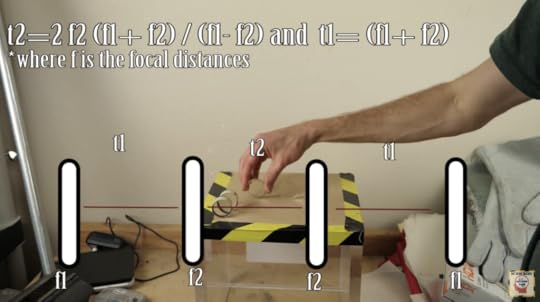
I myself am terrible at math, but don’t worry if you are, too. The explanation in the video is so concise that almost anyone could make their own Rochester Cloak device with a few repeat viewings.
The Action Lab also shows off drawing on water, making a space suit out of duct tape, an attempt to make Spider-Man’s webbing, and much more.
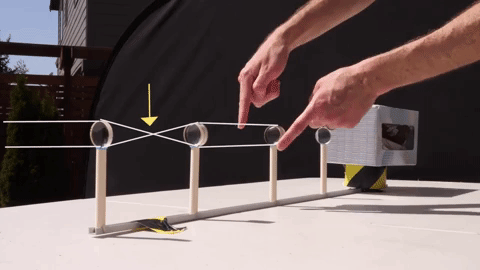
While this video might not show off an invisibility cloak that you can use to sneak into the forbidden section of the library, The Action Lab’s straightforward walkthroughs of various weird-but-true scientific topics are a nice reminder that even the real world can feel magical sometimes.
And if you want even more fascinating science facts based on your favorite characters and concepts in pop culture, take a look at Nerdist’s own Kyle Hill on the Because Science YouTube channel!
If you were invisible, where would you go? Tell us in the comments.
Images: Warner Bros., The Action Lab
More science for your head.
How to beat carnival game scams.
The science of why your cats knock stuff over all the time.
The science of “hangry.”
Chris Hardwick's Blog
- Chris Hardwick's profile
- 132 followers


